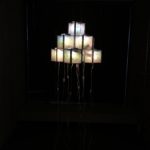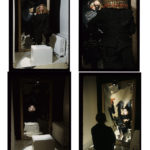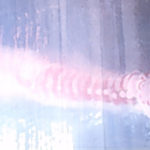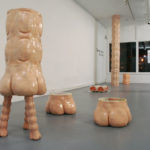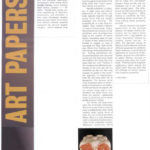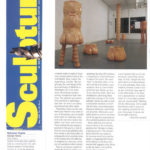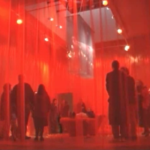Faculty Highlight: Carolyn Henne
Professor Carolyn Henne
Department of Art
Interview by Victoria Salgado
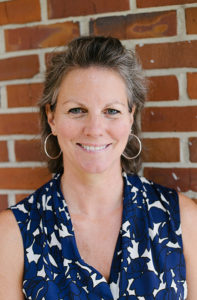 Your initial degree was actually in economics. How did you begin making art, specifically sculptures? Did you start off in other mediums, or was ceramics your pathway into art?
Your initial degree was actually in economics. How did you begin making art, specifically sculptures? Did you start off in other mediums, or was ceramics your pathway into art?
My pathway into art is very complex. When I went to undergrad, my parents said, “You are not majoring in art. You’re going to be an engineer, so you’re going to take physics classes.” Well, that didn’t last very long. I dropped my first physics class and picked up an art class. I negotiated with them and ended up double majoring in Economics and Fine arts. I sold the idea that economics was how I was going to get a job—and I did. I studied art at the undergraduate level. It was a B.A, so it was not as intensive as a BFA. I had a strong interest in architecture, so I took a lot of courses focused on that. Even though they didn’t have an architecture school, I applied to architecture schools to transfer. And I said, “I don’t know, I’m having fun here.” I didn’t transfer and I got a job with an agricultural economist after I graduated. His clients were grain farmers and this was year 1983, 1984, where the bottom fell out of the grain market. It was a bit disastrous and depressing to work there, but I learned a lot. We were on the Internet before anybody else really—farmers are actually pretty high tech people. They were on what was called the Agranet, which was part of the Internet. I learned a ton of stuff in that job even though I realized I didn’t want to do it. I really wanted to study art. Just by happenstance, I discovered an art school in the south of France and I applied to go there. They accepted me and they accepted all the money I was going to pay to go. I didn’t have much to show them but they accepted me. And that pretty much changed my life. I like all the bumps along the way because I learned a lot from doing things I didn’t want to do, but then I eventually came around to the arts. So I went to the school in the south of France and I studied for a summer and then for a whole fall semester. I got hired to come back in the summertime, so I traveled in the spring and came back and worked there. That was my early arts administration experience, still making a lot of art in a beautiful place. I applied to grad school. I was a resident of Virginia, so I was thinking, “Well, what are the best art schools?” I applied to Virginia Commonwealth University and I was accepted. I went there and studied sculpture—by then I had figured out that I was definitely a 3-D person. I worked on movies making props. All through grad school, I waited tables. I learned so much about people which helped in general, but, in particular, helped with all the years of an administration that I did.
Could you describe the formative experiences that solidified your desire to work in sculpture?
In undergrad, I was very much about building things and we didn’t have much of a shop to build anything, but I would make stuff from cardboard and that kind of material. It was always a lot easier for me to think with my hands, to make something rather than draw it.
What got you interested in anatomical 3-D projects?
That interest came from an interesting casting from life, from the body, and building work with those casts. Many years ago, I took a mold of my whole body and cut it up into tiles. I think of those tiles as tools for making work, so I still use them to create. Sometimes it’s just about the abstract shapes that I can make with them. As I was working with those, I started working with internal profiles. For example, if I have the tiles that made up the surface around my hips and connect all those, I could see that internal profile. It’s something you can’t necessarily see unless you’re using some sort of medical equipment. So I was working with those a lot and then I discovered the Visible Human Project. When I was seeing those images with these cross sections, I knew exactly what I was looking at because those shapes were so familiar to me. That’s where the real interest in anatomy came from because I’m super interested in thinking about how this envelope (our skin) contains so much that’s not evident. Anatomy is very useful for thinking about all our internal dialogue and all other things that occur internally, whether that’s physical, emotional, intellectual. I started using that imagery to make some pieces.
How do you work as an artist? Do you begin with a concept or experiment with the materials and let the ideas come that way?
I usually start with an idea, but it’s fairly half-baked. A few little drawings and maybe some notes, then I get started. The wonderful, and frustrating, thing about sculpture is that the entire world is your palette, you can use anything in the whole world to make sculpture. Sometimes the hardest part is figuring out what materials you want to use. For the longest time when I was younger, that was a big hurdle for me. Now I just try to jump in, work on the idea with what’s around me, and not feel so committed to those materials or even the idea. I see where I can get with what I’ve got. Then I regroup and ask, “What’s the next iteration?”
You previously worked with art students from Qatar on a performance art project called Rahal, and with medical professionals to create surgical trainers. What is the experience collaborating with others outside of your field? How is it different than collaborating with other artists?
The Rahal piece was so great. I learned so much from working with those young women. They weren’t necessarily outside my field, but they were certainly a great distance from where I was. As a residency, I did go to Qatar for a week to work with them. It took a long time to figure out what I was going to do with them. Finally, I said, “Well, I’m just going to start making this piece and then I’m going to share what I think this piece is or could be, and how they might be able to contribute to it.” They taught me how the piece I was making held all this other meaning to their culture and where they started in Qatar. They were very poor and they were mostly pearl divers and itinerant people. Of course, now they’re the richest people per capita on the planet because they discovered oil and gas. But they still are very reverential of where they came from and the stories of their roots. They talked to me about what they thought the piece was about and then they brought in this one song, Rahal, into the whole thing. They built this boat contraption, but then they decided that they wanted to do a performance where they would be the water. This was super unusual. Even though Qatar at the time was probably one of the most liberal-leaning countries of the Arabian Peninsula, it was still fairly conservative—women just didn’t really perform, especially in front of a mixed gender audience. So this was a big deal. That’s why they’re wearing masks but they designed their own attire. They choreographed the performance. They hired a DJ, so there were all these fancy lights. Then they did this performance around this piece. It was really a beautiful thing. People were very moved. I learned so much from them about pushing your own limits, going beyond your comfort zone, and how an image that strong to you can be as strong for somebody from another culture. I learned that there will be overlaps in the way that you think about a piece and interpret a piece and there will be divergent interpretations of it. So, that was great fun.
The medical trainers—those started from a project with students from business, engineering, and the arts. I continued to work with the surgeon that was involved to finish the design. The thing that I learned the most from that is students, especially at the undergraduate level, may be engineers or business students or art students but they bring a lot of skills across the spectrum to the project. Some of the business students were major contributors to the design and creation of the trainer and some of the art students were very savvy business people, thinking of how to pitch the project. That’s not such a far reach because art students generally have to stand by and defend their work. This concept of packaging an idea and articulating it is something that artists do. That’s part of what they learn to do in school. And the engineers contributed all around. It was a lot of fun to do.
The surgeon and I… She’s a person who works with her hands too. We just very naturally collaborated to get to where she wanted to get to in terms of utility. We talked about the kinds of things that were needed, and then I would be left to my own devices. I didn’t finish that until I moved to Tallahassee. So when I first got here, I got a studio and finished that, shipped it off and the rest is surgical trainer history I suppose. [laughs]
In that instance, your objectives and visions aligned with your collaborators’. How would you negotiate disconnects within collaborations?
Another colleague of mine named Judy Rushin—she and I have a collaboration called Comma. I’ve been collaborating with her for about a year now and we’re realizing that we want to actually increase the differences between the people that we’re collaborating with, so our next proposal is that we work with writers. We think that because each group is coming from such different points of view, that that will yield some really interesting results that neither one could have arrived at. We’re really intrigued by that idea and we’re hoping that writers would be intrigued by seeing some concrete outcomes from our collaborations.
Why sculpture, and not other mediums or processes?
I do use other mediums or processes—I’m just not very good at it. [laughs] In the past, I have incorporated painting or drawing into my work. Most of the time that that ends up on the sculpture though. But I have had 3-D sculptures interfacing with paintings. Like I was mentioning before, it’s so much easier for me to think with my hands than draw or plan something out. It’s easier for me to be more visceral. When I’m drawing or painting or something, I’m thinking too hard, whereas sometimes with sculpture I don’t have to think very much. I can just get going and see what happens. The materials often tell you what’s going to happen and then you go, “Oh, that’s not what I thought I was going to be doing today.” Then you have to sit back and ask, “Do I need to get in control of these materials and realize what I thought I was going to realize? Or do I want to take advantage of this?” You know as they always talk about the happy accident.
Looking across your body of work, from that summer in the south of France to this era of your life, how would you describe the evolution of your art practices?
I was in an administration for 7 years here at FSU and 7 years at Virginia Commonwealth University. What can really happen with administration is you become particularly efficient in your studio because you don’t have enough time to be anything else. I feel like I’m actively working to try to get back to that person that was messing around with materials and stuff in Lacoste until I got into administration. And it’s harder than you think because you have a tendency to say, “OK, let’s make make use of this time” instead of devoting time to allow yourself to be bored and unproductive while in your studio. Maybe you’re going to waste your whole day, but you’re going to be messing around. I haven’t been like that in 14 years. That’s what I’m working on now: to not evolve but to regress. [laughs]
You’ve taken several leadership positions, like being director of the Facility for Arts Research (FAR), an Associate Dean, and Department of Art Chair. What attracted you to these roles?
This is a great life lesson. Just because you’re good at something doesn’t mean you have to do it. I’m very organized and I was always considered to have a lot of leadership potential, so I was offered opportunities. I thought, “Well, I need to give this a shot.” Then it evolves. There’s an expectation that you’re going to go from this position in a department to this position in a Dean’s office to, of course, being Dean. Well, I didn’t want to be Dean. Never. There’s this great book by Rebecca Traister called Good and Mad. We’re trained as women to be very good people and meet other people’s expectations. It took a lot for me to realize, “I don’t need to do this anymore. I want to do something else that I consider myself to be good at. I want to make art and I want to teach.”
How did you cast aside those expectations to pursue other endeavors?
It’s tough. And people try to convince you that you’re wrong. [laughs] It really goes back to the story I told you at the beginning, which is I was meeting my parents’ expectations. But I don’t think of it as wasting time. I think that all of these experiences feed into the person that you become. So yes, I was drawn into being an agricultural economist for a while, I was drawn into a bad marriage. [laughs] I was drawn into administration. I learned a whole lot from all of them, so I’m really happy that they all went the way they went. But at a certain point you realize, “Oh OK, I need to stop.” I’ve always been pretty good at saying I’m not enjoying something anymore and that I don’t feel like I need to spend 40, 50, 60, 70 hours a week on something I’m not enjoying. So now I’m spending 40, 50, 60, 70 hours a week on something that I do.
What would you say is at the heart of your work? Would you say that central message has evolved as you continued creating art?
Every once in while, I’ll go back and look at my old work or my old sketchbooks and go, “Wow… I’m still working on the same thing, only in a different way.” It’s always a different way. I think maybe my work is not as reactionary as it was when I was younger. It might be a little more complex and nuanced. Before, I needed to make this work in response to this event. I don’t think that’s necessarily how I’m working anymore.
I often tell my students to keep all their sketchbooks, keep all their notes—to make notes because they’re going to want to go back and visit themselves 5, 10, 30, 40 years later and see what that person was like. You think you’re going to remember but you won’t.
How do you know when a work is done?
Deadlines help. If you have a deadline, that can be a big factor in how you make adjustments throughout your process. But the thing I love to think about is: a piece might be done for a number of different reasons, but the most important piece is the next piece I’m going to make. So the only function a piece has is to inform what I’m going to do in the future. Yes, I’ll call it done, but it’s never really done. And I will revisit it, physically or conceptually.
You discussed a set of tiles that you use in conjunction with the Visible Human Project. Do you consider those your most important artistic tools? Is there something else you can’t live without in your studio?
I have a really favorite scraper. I lost it. I had to buy a new one. But this new one, I’m pretty into it. I make a lot of messes, so I need to scrape a lot of things. But more seriously, I use so many different tools. I work in wood, fabric, metals, rubber, foam rubber, whatever. I do have some favorite things like a hole puncher. I can’t find it right now, but it’s somewhere. I have a lot of tools though. I misuse all of my tools. I often use them the wrong way because my materials are so gooey and messy. But they’re my tools, so I can do that.
What’s your daily routine in this studio?
There’s no consistency. During the semester, it’s just built around the time that you can find. In the summertime that becomes much more consistent, so I just try to spend the day into the evening in the studio and take breaks for exercise and food.
How do you negotiate your responsibilities as a professor and human being with creating art?
I’m always learning from my students. Teaching also forces you to articulate the things that you think are important about art making. When you’re forced to say those things, it gives you a better sense of where you’re at. That does feed back into the studio. So I don’t find teaching tiresome or exhausting. I love teaching. And then the other responsibilities, I’m just very happy to help with the department and the college because I have spent a lot of time in leadership roles in these entities. I feel very vested in its success, and a lot of the faculty feel that way. So that’s not a problem. We just do what we need to do.
How do you get your work out to the public?
I’m new to doing that because I really was not in my studio enough to pursue that before, so it’s wonderful being in this collaboration with Judy Rushin because she is so forward thinking. It’s almost like I’m getting trained to think that way again. She helps me raise my head up out of my making mode and think, “OK, what are we going to do here?” So we’ve been very actively promoting our project. She had a solo show up in Pennsylvania and we proposed to them that we use one of the galleries that she had, for Comma. We drove that show all the way up to Pennsylvania and we stopped at a couple of different places on the way up and met with gallery directors and, in one case, a museum director and talked to them about our project. I think a really important part of it is the networking. People need to know about you. You don’t have to expect anything from them. When we took the show down, we drove back down and went a different route. We stopped in Atlanta and had a number of meetings there. Actually, we ended up getting a show at a pretty prestigious gallery there called White Space. We’re super excited about it. And we have a number of other potential shows.
Another way to get work out is to apply for grant money so that we can continue to make our projects and plan our projects into the future so we can get honoraria for our collaborators, get money for materials, and that kind of thing. And then, of course, for example, when we have the show at White Space, they’ll be really good at getting the PR out. So we’ll probably get some press coverage online, maybe in the paper, maybe in a journal, like Art Papers (which I think is located in Atlanta). We’ll just grow our profile that way.
How do you balance the paperwork and bureacracy with the actual artmaking?
The deadlines, quite frankly. You obviously have to do the research to find the right opportunities. But there’s not that much out there for us right now in terms of grant money. We keep getting new opportunities for exhibition venues and that sort of thing, so we have to apply for those, but there’s always a deadline somewhere. We force ourselves to plan ahead. We just met two major deadlines.
Is there a piece of art or an exhibition that you’re most proud of?
This took place back in early 2002. It was called There’s Here, and it was a massive installation. There were two huge galleries connected with a mezzanine. The upstairs gallery had a big opening down into the first floor gallery. And I activated that entire space. I still feel very proud of that work; a component of it is in the National Museum of Health and Medicine. It was also in the show at the National Institute of Health. That work also got probably the most attention. It was well-reviewed, I was in Art Papers and Sculpture magazine. I was proud of it, but I was also able to get a fair amount of real coverage for the work.
How did you end up at FSU?
I was at VCU. When I get to a point in a position where I’m thinking, “I have done what I wanted to do with this,” I start looking around to make a change. The Dean’s office was a great place to be, but I didn’t really see a place there for me. I always want to stay within the arts, so I started applying for jobs and FSU turned up. I definitely wanted to move south because it’s warmer here than anywhere that I have lived in the past. With that criteria, I applied for positions. I felt like I still wanted to do administration and I thought a position as a Chair would be a good experience for me because I hadn’t done that before. This faculty is extremely strong in their research and they’re really dedicated to their teaching and to the Department. I just saw a lot of opportunity here. There was a lack of structure and I thought, “Well, I can help with that.” So, that’s how I ended up here.
How would you describe your teaching practices?
I try something different all the time so I’m constantly tweaking. I’m listening to my students in real time, but I’m also reading my evaluations and applying what I read there. I really value that students will take the time to write things out and express what they thought worked and didn’t work. I try to be a good communicator, and model that for my students because I feel like a lot of times when students are struggling, it’s either because they didn’t understand exactly what was going on or they’re not communicating with me about their challenges. I also know this about myself: I’ll think I explain something, but I might leave something critical out to someone who doesn’t know anything about what I’m saying. I try to think about my teachings, I’m very meta about it. And I try to push students. I’m not a nurturing person, but I do try to be an understanding person and a person that pushes, but not too hard, not too far. I try to get students to be very thoughtful about what they’re saying in critiques. I spend a lot of time in critiques, talking about the way we’re talking about this matter. Meta.
As a professor and artist, what is the most vital idea or lesson that you want to instill in students?
That you’re never done. This piece is just about the next piece. That’s why failure is so welcome. Because you can just learn from it. But you can’t fail and you can’t succeed unless you’re working.
- Art Papers Review
- There’s here Art Papers review
- Sculpture Review
- There’s Here video still

